Wombat: Australia's Burrowing Marsupial
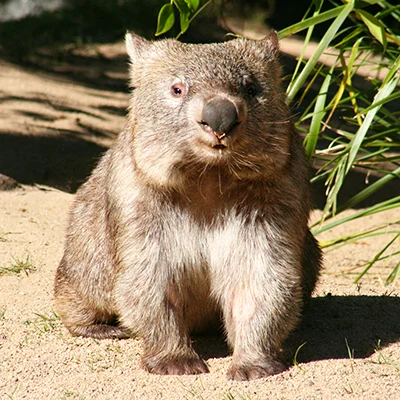
Contents
What is a Wombat?
Wombats are quirky, burrowing marsupials known for their sturdy bodies, powerful legs, and distinctive slow, waddling gait. They are typically about 1 meter (3.3 feet) long, weigh up to 40 kg (88 lbs) and have soft, light brown to black fur, broad snouts, thick whiskers, wombats. Although they have small eyes and limited vision, wombats have exceptional senses of smell and hearing, along with the ability to detect even the faintest ground vibrations. Often thought of as slow-moving creatures, wombats can actually sprint at speeds of up to 40 km/h. This is almost as fast as Usain Bolt, the fastest human, who reached 44kph.
These nocturnal animals spend the majority of their time resting in the safety of burrows they dig with their sharp claws. While shy and solitary, wombats aren't afraid to defend themselves if threatened, and may grunt or even attack when cornered. One of their most remarkable features is their cube-shaped poop,(faeces), an oddity in the animal kingdom.
Closely related to the koala, wombats are the smartest marsupials, with an impressive ability to navigate their underground tunnels. Their fascinating behaviours and abilities make them one of Australia’s most intriguing and endearing wildlife species.
Wombat's Remarkable Defence: Its Deadly Butt
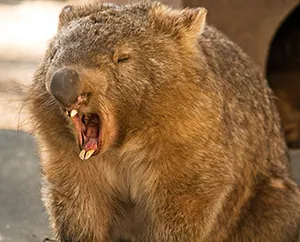
Wombats have a unique defence mechanism — its their buts! Their extremely tough rear ends are made up of fused bony plates covered in cartilage, fat, and thick skin. When threatened, a wombat will point its well-padded rear at an attacker, using its “shield” to protect itself. If a predator gets too close, the wombat will flee to the nearest burrow and block the burrow entrance with its rump, preventing the predator from following it in. In dire situations, wombats have been known to defend themselves by smashing an attacker's head against the roof or wall of the burrow with their hard well-protected rump.
Click here for an excellent explanation and video of a wombat attack
Wombat's Cube-Shaped Poop
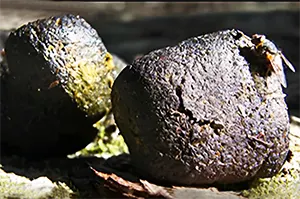
Photo: Cube-shaped wombat poop (faeces)
One of the most peculiar and fascinating characteristics of wombats is their cube-shaped poop.
Unlike most animals, wombats produce approximately 100 six-sided, 2cm cubes of faeces each day. Their unique shape prevents the poop from rolling away and it helps wombats mark their territory and helping wombats find their burrows in the dark. The poop also advertises their age, sex, sexual maturity, and health status to other wombats.
Here is an excellent explanation and video about Wombat's Cube-Shaped Poop
Wombats Species
There are three species of wombat: the Common Wombat and two species of Hairy-nosed Wombats.
Common Wombat (Vombatus ursinus)
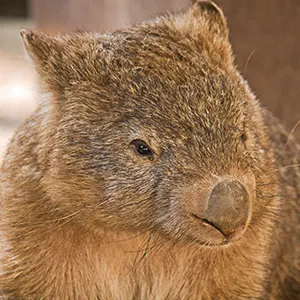
Photo: Wombat Face
The common wombat, also known as a bare-nosed wombat, has a bare, pointed nose, small ears, and coarse brown fur. It has short ears, a narrow snout, rough fur, and no hair in its nose. Its front paws are more dexterous than that of the hairy-nosed variety. Common wombats weigh between 22–39kg. They are nocturnal during the summer, but in winter, they often come out of their burrows during the day to feed and sun themselves.
Hairy-nosed Wombat (Two Types)
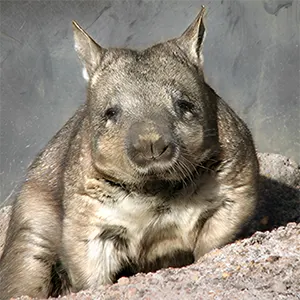
Photo: Hairy-nosed Wombat
There are two types of Hairy-nosed wombats. They have larger ears, a hairier noses, slightly longer heads with squarer snouts, and softer fur compared to the common wombat. These wombats are genetically very different from their distant cousins, the common wombats. Hairy-nosed wombats receive sufficient moisture from their diet and do not need to drink.
Northern Hairy-nosed Wombat (Lasiorhinus krefftii) is the largest of the three species of wombats, measuring up to a meter in length and weighing up to 32 kilos. The female is larger than the male. They are only found in a very small area of Queensland and are critically endangered. Only about 100 survive in the wild. They were once found throughout the arid inland parts of Victoria and up to Queensland.
Southern Hairy-nosed Wombat (Lasiorhinus latifrons) is the smallest of the wombat species. An adult weighing about 23 kilos and the male is larger than the female. They prefer the coastal and high country of south-eastern Australia and are the most adapted to arid climates.
A Curious Wombat Fact
Did You Know: Even though wombat species are related, the hairy-nosed wombat is genetically very different from the common wombat. Their genetic codes are around 8% different. This difference in genes is higher than between humans and chimpanzees, which is only 2% different.
Wombat Habitat: Where Do They Live?
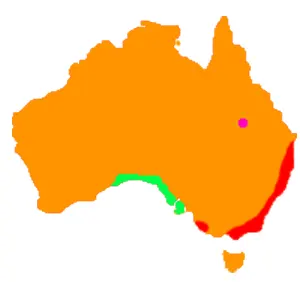
Photo: Wombat Habitat Map
Wombats live in temperate forests, grasslands, and eucalypt woodlands across eastern Australia, southern Australia, and parts of Tasmania. Wombats are territorial and solitary, often marking their territory with their distinct faeces and scent glands. Wombat ranges may overlap, but they do not actively defend their territories; they just keep out of each other's way.
Common Wombat: Found in temperate forests and grasslands of eastern Australia. (Red areas of the map).
Northern Hairy-nosed Wombat: Only found in a small area of east-central Queensland in semi-arid grasslands and eucalypt woodlands. (Little purple dot on the map).
Southern Hairy-nosed Wombat: Only lives in parts of southern South Australia and south-western Western Australia in semi-arid grasslands and eucalypt woodlands. (Green area on the map).
Wombat - Burrow: The Wombat's Home
A wombat is very fond of its burrows, which can be up to 20m long and include as many as 50 entrances and offer shelter from predators, extreme temperatures, and bushfires. These tunnels feature multiple entrances and sleeping quarters.
Wombat Diet: What Do Wombats Eat?
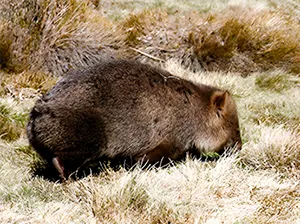
Photo: Wombat foraging for food
Wombats are herbivores, primarily feeding on grasses, roots, tree bark, and succulent plants. They are nocturnal grazers, coming out at night to feed, although during cooler months, they may forage during the day.
Wombats have a prolonged digestive process. Food can take up to 8 days to pass through its gut. This enables the wombats to extract the maximum energy and moisture from their generally poor-quality diet.
Wombat Reproduction & Life Cycle: Baby Wombat
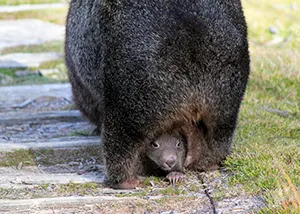
Photo: Wombat baby (joey) in rear-facing pouch
Wombats usually breed between October and January. After mating, the female's gestation lasts around 20-30 days. The tiny joey, which is no larger than a jelly bean at birth, crawls into its mother's backward-facing pouch.
The joey remains in the pouch for 6-10 months before becoming more independent. Wombats reach sexual maturity at around 2 years of age and can live up to 15 years in the wild.
Wombats Threats and Predators
The major threats to the wombat today are land clearing, motor vehicle impacts, dingoes, foxes, and dogs. Until the mid 20th century, wombats were considered as pests because of their burrowing, damage they caused to fencing and grazing competition with pastoral livestock. There were bounties for killing wombats.
Is the Wombat Endangered?
While the common wombat and southern hairy-nosed wombat are not considered endangered, the northern hairy-nosed wombat is critically endangered, with only around 100 individuals left in the wild. The major threats to wombats include:
• Habitat loss due to land clearing and urban development.
• Predators like foxes and dingoes.
• Vehicle collisions and livestock competition for food.
Wombats are protected in most parts of Australia, and conservation efforts are focused on preserving their habitats and increasing their populations.
How the Wombat Got its Name
Early European settlers referred to these animals as badgers because they were about the same size and behaved like that animal back in Europe. A white settler, named John Price first wrote about this animal in 1798 and called it a 'Whom-batt'. He was using a name used by the Dharuk Aboriginal people who once lived in the area that is now the city of Sydney. They called this animal a 'wambad'.
Wombats as Pets: Why They're Not a Good Idea
While wombats may appear cute, they are not suitable pets. These wild animals are solitary, territorial, and can become aggressive as they age. They also have sharp claws and strong jaws, making them dangerous if provoked. Furthermore, it is illegal to keep wombats as pets in most parts of Australia.
The Extinct Giant Wombat: Diprotodon
One of the most evocative extinct creatures to have lived in Australia is the Giant Wombat. These creatures, also known as Diprotodon, were massive, measuring up to two meters in length, weighing 180-250 kgs, and as tall as an adult human. However, unlike their smaller present-day contemporaries, these animals didn't burrow into the ground. Instead, they lived an above-ground life. Fossil records suggest that these massive wombats went extinct around 40,000 years ago. Two theories have been put forward for their extinction. The first is climate change, where Australia became drier and more arid depriving these huge animals of their food supply. The second is that early Aborigines may have hunted down these huge, slow-moving animals hastening their extinction.
25 Wombat Facts
- The wombat is a burrowing marsupial that lives in Australia.
- Wombats have short, stumpy legs but can run at speeds of up to 40 kph.
- It is the second-largest marsupial.
- It is the only animal that does cube-shaped poo.
- The wombat's closest relative is the koala.
- They are the most intelligent marsupial.
- It uses its thickly padded bottom as a shield by pointing it at attackers.
- It often uses its rear to block the entrance to its burrow.
- Males and females are similar in size.
- Wombats have weak eyesight.
- But compensate with an excellent sense of smell and hearing.
- Wombats have two incisor teeth on their upper and lower jaws, like rabbits.
- Their teeth grow throughout their lives.
- They eat native grasses, roots, and tree bark.
- They have a tiny tail which is hardly visible at all.
- The female has a backward-facing pouch to prevent dirt from entering it while she digs.
- A group of wombats is called a wisdom, mob or colony.
- Wombats have an extremely low metabolic rate.
- They don't sweat.
- Because of their burrowing habit, wombats can tolerant low oxygen and high carbon dioxide levels in their environment.
- Wombats are not dangerous unless you annoy them.
- Attacks are extremely rare.
- Wombat burrows can reach 20m in length.
- Wombats live for about 15 years.
- The now-extinct giant wombat was as large as a rhinoceros.
All Rights Reserved. (Last Updated: Mar 22, 2025)